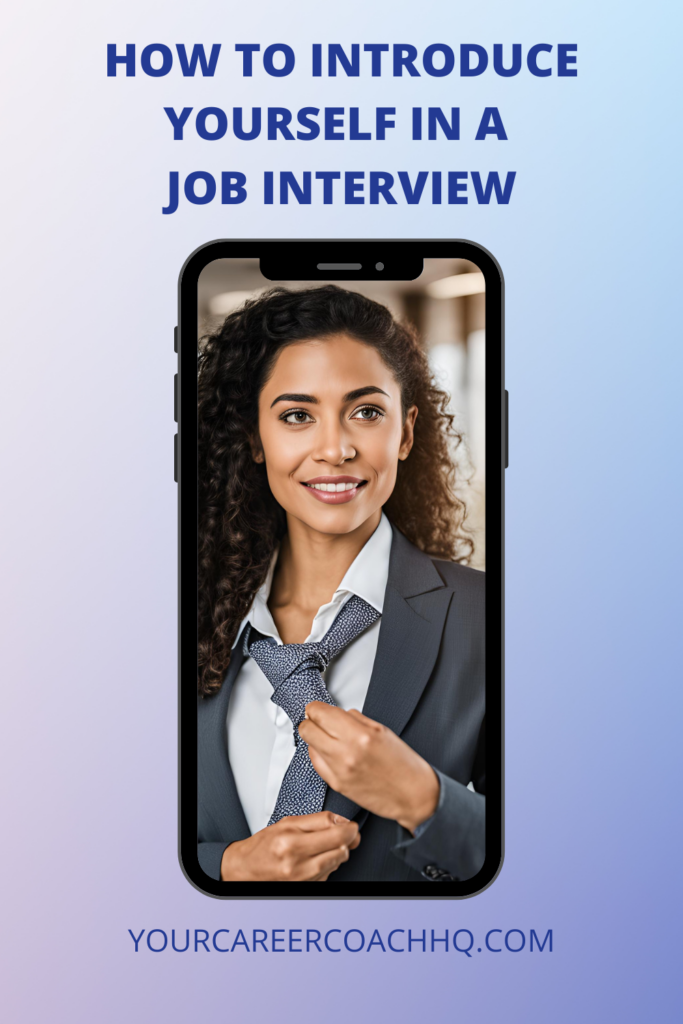What You’ll Gain from This Guide
- Understand the key differences between a self-introduction and a resume.
- Learn the importance of first impressions and how to make them lasting.
- Discover actionable tips on how to introduce yourself in a job interview.
- Explore effective strategies for managing the interview process.
- Get answers to frequently asked questions about job interview introductions.
Introduction
First impressions are powerful—especially in job interviews. Knowing how to introduce yourself is key!
In just a few moments, interviewers assess your demeanor, confidence, and suitability for the role.
The first words you speak are an opportunity to set a positive tone for the entire interview.

In this guide, we’ll walk you through practical steps to create a polished and engaging self-introduction.
Whether you’re a seasoned professional or a fresher, these strategies will help you stand out for all the right reasons.
Download our 100 interview questions and answers to stand out.
1. Self-Introduction vs. Resume: What’s the Difference?
A resume is a structured document that showcases your skills and experiences, while a self-introduction is your chance to personalize those achievements and connect with your interviewer.
| Aspect | Self-Introduction | Resume |
| Purpose | Build rapport and showcase personality. | Highlight qualifications and skills. |
| Format | Informal and conversational. | Formal and structured. |
| Length | 1-2 minutes spoken. | 1-2 pages written. |
| Usage | Used in interviews and networking events. | Used for job applications. |
“Your resume gets you the interview; your self-introduction gets you the job.”
2. Why First Impressions Matter
First impressions influence how interviewers perceive you for the remainder of the conversation.
Research shows that decisions about a candidate’s potential can be made within the first few minutes.
Download our 100 interview questions and answers to stand out.
How to Make a Lasting First Impression:
- Prepare and rehearse your introduction.
- Dress professionally to match the company’s culture.
- Arrive early to convey punctuality and preparation.
- Use confident body language—stand tall, smile, and make eye contact.
3. How to Introduce Yourself Effectively

Key Elements to Include:
- Your Skills and Qualities Highlight abilities that directly align with the role. For example, “I’m detail-oriented and excel in project management, which I believe will help in this role.”
- Relevant Experience and Qualifications Share your professional history or academic background briefly. If possible, tie these to the company’s goals.
- Significant Achievements Use specific examples to demonstrate your impact, such as, “In my previous role, I increased efficiency by 15%, saving the company $20,000 annually.”
- Your Personality and Future Contributions Showcase traits like adaptability or collaboration and explain how they’ll benefit the team.
4. Sample Introduction Script
“Thank you for this opportunity. I’m [Your Name], and I recently [mention your recent accomplishment, such as graduating or completing a significant project].
I have [X years] of experience in [industry/role] and have developed strong [mention key skills relevant to the role, e.g., analytical skills or leadership]. In my last role at [Company Name], I successfully [mention a specific achievement].
I’m particularly excited about this position because [highlight alignment with the company’s mission or values], and I’m eager to contribute by [mention specific ways you can add value].”
5. Tips for a Memorable Introduction
- Practice Makes Perfect Rehearse your introduction aloud to sound confident and natural.
- Adapt to the Context Customize your introduction based on the company and role.
- Maintain Positive Body Language Sit upright, avoid fidgeting, and smile genuinely.
- Use Visual Aids if Appropriate For virtual interviews, ensure your background is clean and professional.
- Follow Up with a Thank-You Note A brief message expressing gratitude can leave a lasting impression.
Conclusion
Your self-introduction sets the stage for a successful job interview. By preparing and practicing, you can confidently present your strengths and align them with the company’s needs. Remember, interviews are learning experiences, so use each one to refine your approach.
Call to Action: Have any tips or experiences to share? Comment below! Don’t forget to share this guide with friends or colleagues preparing for their next interview.

Download our 100 interview questions and answers to stand out.
Frequently Asked Questions
How to Introduce Yourself in an Interview Sample Answer
“Thank you for this opportunity. I am [Your Name], with a background in [field] and [X years] of experience. In my previous role at [Company], I achieved [specific accomplishment]. I am excited to bring my expertise in [mention skills] to your team.”
What Are 5 Tips for a Successful Job Interview?
- Research the company and role thoroughly.
- Prepare clear, concise answers to common questions.
- Dress professionally.
- Practice your self-introduction.
- Follow up with a thank-you note.
Interview Tips: Tell Me About Yourself
Start with a brief overview of your background, highlight key achievements relevant to the role, and end with your excitement about the opportunity.
Self-Introduction Sample for Job Interview Fresher
“Hello, I’m [Your Name], a recent graduate in [field] from [university]. During my studies, I focused on [specific skills or projects]. I’m excited to start my career at [Company Name], where I can contribute [specific qualities or skills].”
How to Introduce Yourself in an Interview as a Student
“Hi, my name is [Your Name], and I’m currently studying [major] at [university]. I’ve developed skills in [specific areas] through my coursework and internships. I’m eager to bring this knowledge to [Company Name].”
How to Introduce Yourself in Interview Sample Answer for Freshers
“Good morning. I’m [Your Name], and I recently graduated in [field]. I completed an internship at [Company], where I gained experience in [skills]. I’m excited about this role at [Company Name] because it aligns with my passion for [specific interest].”
10 Things to Do During an Interview
- Arrive early.
- Greet with a firm handshake and smile.
- Maintain eye contact.
- Actively listen.
- Ask insightful questions.
- Use examples to support your answers.
- Be genuine and confident.
- Stay calm under pressure.
- Thank the interviewers.
- Follow up post-interview.
How to Introduce Yourself in an Online Interview
Online interviews come with their own unique challenges, but with the right approach, you can make a stellar impression.
Start by setting the stage for success: ensure your background is clean and free from distractions, your lighting is bright yet natural, and your internet connection is strong.
Dress professionally from head to toe—yes, even if the bottom half won’t be visible, it’ll help you feel fully prepared and confident.
When it’s time to introduce yourself, look directly into the camera, not at the screen, to simulate eye contact with your interviewer.
Begin with a warm, friendly greeting, followed by your tailored introduction.
Highlight your skills, experiences, and achievements relevant to the role, but keep your tone conversational and engaging.
Show enthusiasm with your voice and facial expressions to counteract the potential lack of physical presence in the room.
Additionally, adapt your approach to the virtual setting.
For instance, have a copy of your resume or notes handy (off-screen) for quick reference, and practice beforehand using the platform to ensure you’re comfortable navigating its features.
Finally, end your introduction with a smile and a concise statement that ties your background to how you can contribute to the company’s goals.
By combining preparation with confidence and a touch of professionalism, you’ll leave a lasting impression, even through a screen!
Download Your 100 Questions & Answers
To further aid your preparation, make sure you download our 100 interview questions and answers.
This resource is designed to help you navigate through various questions and provide well-structured answers.
Having a script at your disposal can enhance your confidence and readiness.
Related Resources
This post is part of a series on excelling in job interviews. Check out the other articles in this series:
100 Interview Questions and Answers to Ace Your Job Interview
How to Answer Salary Expectations Interview Question: Best Example Answers
How to Pass a Phone Interview (Phone Interview Questions and Answers)
Top 10 Best Interview Tips: How to Prepare for a Job Interview




